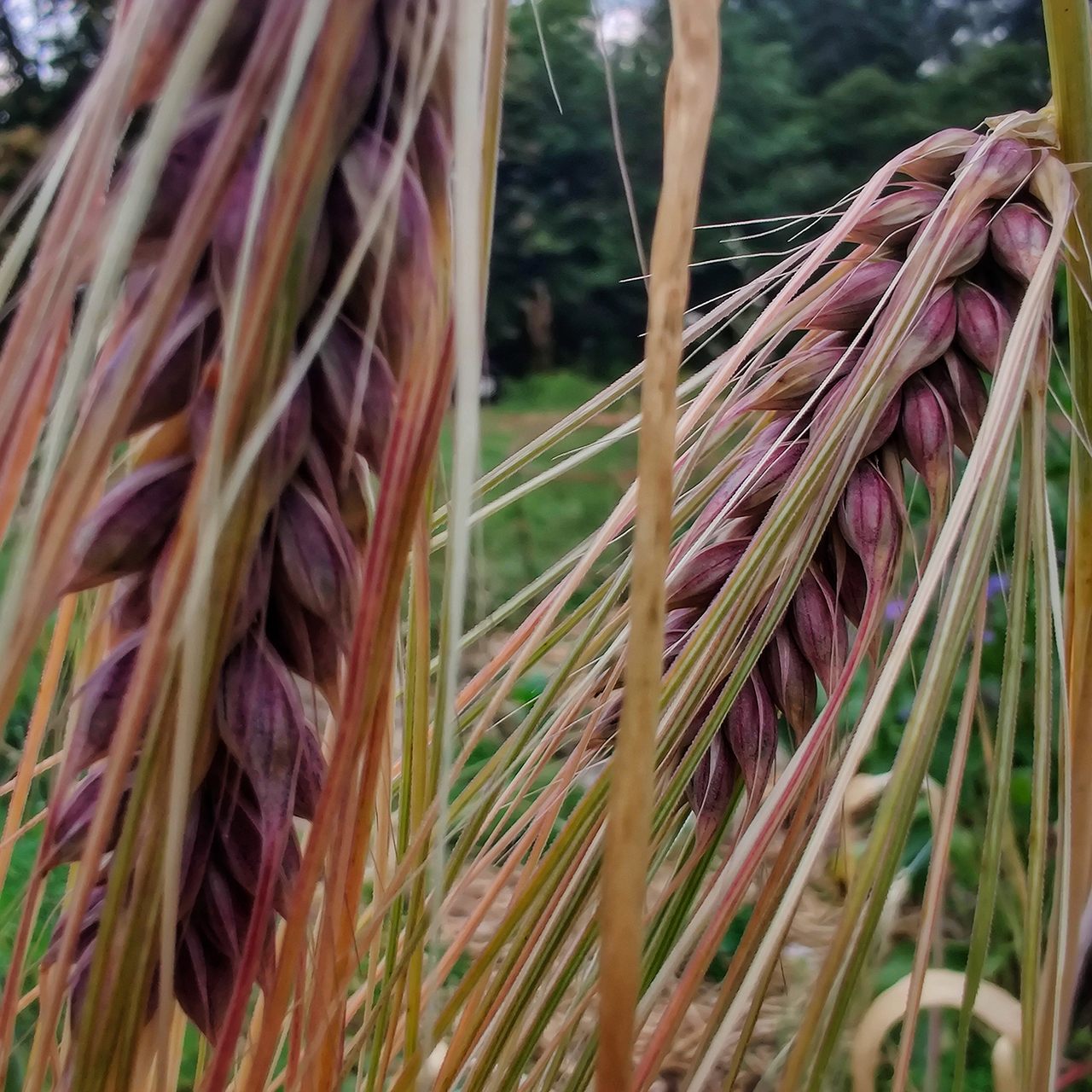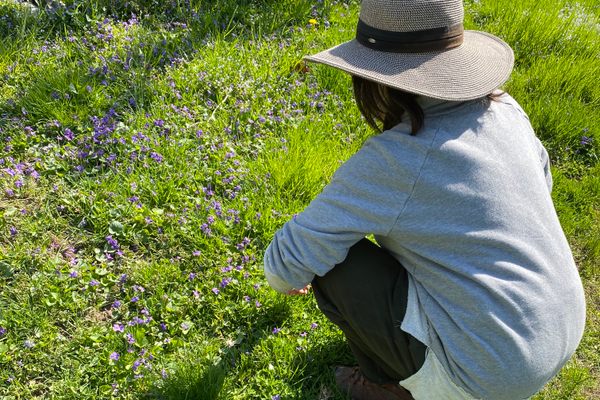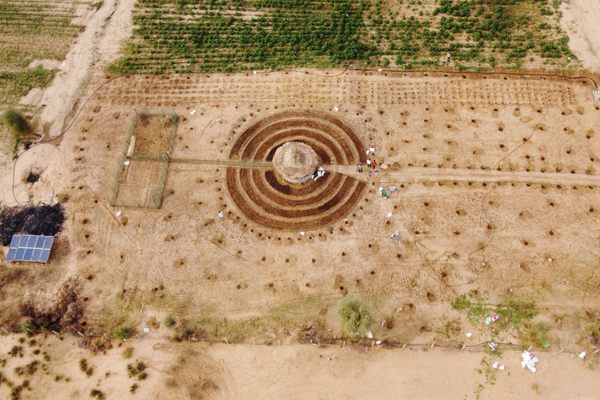Turn Your Garden Into an ‘Ark of Taste’ for Nearly Lost Plants
Slow Food’s annual “Plant a Seed Kit” encourages home-gardeners to cultivate rare and endangered crops.

Slow Food’s Plant a Seed Kit is an initiative that seeks to get Ark of Taste seeds—rare, endangered, diverse and distinctive foods—into home gardens. And every purchased kit pays for a free kit for a schoolhouse garden. For 2024, the kit includes four grains to grow at a garden scale: Cocke’s Prolific Corn, Coral Sudanese Sorghum, Purple Karma Barley, and Red Fife Wheat.
I spoke to Mara Welton, director of programs at Slow Food USA. A former farmer who ran her own biodiverse vegetable farm for 17 years, she’s the expert that curates each year’s kit. Feel doubtful about your ability to grow, harvest, and process these heirloom grains? Mara has all the advice you need, as well as encouragement for why it’s worth planting these grains in our gardens.
This interview has been edited for clarity and length.
Sarah Lohman: I understand every year of the Plant a Seed Kit has a theme?
Mara Welton: The kit used to be like a garden in a box—you’d have a tomato, a pepper, an herb, something like that. But starting in 2022, we decided to have a singular crop focus each year. First was beans, then greens in 2023—collards, chicory, mustards, and lettuces. This year, roots and grains. And for 2025 we’re gonna move to fruits and fruiting vegetables. The whole campaign has a four-year cycle, mimicking a crop cycle.
SL: How do you decide what seeds go in each year’s kit?
MW: My goal is to have at least half of the seeds in the kit be from the Ark of Taste. Also, I’m always trying to think about seeds that will have great success across all of the USDA growing zones. I have conversations with partners like Seed Savers Exchange, The Utopian Seed Project and the Experimental Farm Network. I’ve been leaning on some of those relationships to help me curate these kits so we’re hitting those points of accessibility, interesting crops, and also crops that have a really good story attached to them.

SL: So this year you’re featuring Roots and Grains. I wanna focus on grains for this conversation, but I’d also love to give the roots a little shout-out. Can you tell me briefly about the different roots that are going into the kit?
MW: The roots are fun. They do a lot of good sod busting for you, so if you have hardpan soils or some marginal soils, if you plant roots, it helps your soils get more aerated. One is called the Pardailhan Black Turnip. It’s a French Ark of Taste crop that’s a black turnip that is succulent and delicious. Then there’s the Mangelwurzel Beet, it’s the original sugar beet. I really wanted to introduce people to the original sugar beet and just be like, “Hey, this is an important crop for American agriculture.” It’s an incredible storage crop, they have extremely delicious greens. You can actually make sugar from the sugar beets if you really need the sugar, but you can also just eat it and enjoy it. Then there’s the Wisconsin Purple Carrot. Historical carrots were red, purple, yellow. These older carrots actually are extremely delicious.

SL: So let’s talk about the grains, because I am both intimidated and charmed by having a mini grain field in my backyard. Before we get into the specifics of them, any tips for curious grain growers?
MW: Each kit comes with a little booklet that I curated; not just the stories of every single crop in the kit, but also growing tips and harvesting tips.
Humans have not always had acres and acres and acres of grain. I think that’s a modern human American mentality. We need the amber waves of grain to feed all the people. But you actually don’t need that many. You can get 20 pounds of barley from a 10 x 10 plot.
Some tips: If the bird can see the grain it’s gonna eat the grain. So we recommend mulching after you spread your grain with some straw and keeping it evenly watered so that you can get max germination. If you’re worried about germination for things like the dent corn, you can actually start those in trays. But I would encourage people to just go ahead and stick it in the ground and watch the process.
SL: Okay, Cocke’s Prolific Corn—this is one of these seeds that was really thought to be lost. Can you tell me the story?
MW: It’s not been commercially available since 1951. It turned out that there was one grower in South Carolina—his name was actually Manning Farmer—and his grandson was helping him try to sell some of his seed online in 2017]. He posted something that said like, “Cocke’s Corn seed available.” And one of our Slow Food leaders, Angie Lavezzo, happened to see this post on Craigslist and was like, “Oh my gosh, I think I found some prolific corn,” and contacted him. And then she and David Shields [Southern food scholar and coauthor of The Ark of Taste: Delicious and Distinctive Foods That Define the United States] went down and collected some of the seed, and it was in fact found to be the Cocke’s Prolific Corn that we thought was lost forever.
Manning Farmer lived to be 99 years old and he had been growing it most of his life. He appreciated it as a really delicious grit and cornmeal corn.

SL: What would you do with your Cocke’s Prolific Corn harvest?
MW: Oh, I will probably turn it into hominy. I am a Latina who really loves making posole. And so I’ll nixtamalize my corn and I’ll turn it into hominy. And then I’ll probably grind some of it into grit. You know, I love a good grit.
SL: Okay. So let’s talk about this variety of sorghum.
MW: It’s a variety of sorghum that’s from Malakal, South Sudan. The Shilluk people have been victimized by the ongoing South Sudanese Civil War and have been separated from their food as a result. The Experimental Farm Network has been stewarding this seed, hoping to be able to repatriate it back to the folks when they get their land back. I am really excited for it because it should be really delicious, prolific, and extremely beautiful.
It’s called a grain de cane sorghum, which means that you can use the grain or you can use it for cane syrup. You can have it as a popping grain, a dry grain, you can eat it like pasta. When it’s in its green, milky stage, you can eat it like porridge. A lot of people have grown sorghum as an ornamental, and it’s time to just be like, “Hey, you know what, you’ve seen this in floral arrangement, but guess what? You can eat it.”
SL: What about Purple Karma Barley? Tell me a story.
MW: This is another one [like Coral Sorghum] that is not on the Ark of Taste, but I thought barley is an important crop with a recent resurgence.
One of our partners was affiliated with The Oregon State Barley Breeding Project and I just fell in love with OSU’s Purple Karma Barley because of its prolific nature. It’s an heirloom landrace variety from the Himalayas, from Tibet. The seed was collected around 1924, and then it was just saved in a seed bank for like a hundred years. Which is like the worst place for seeds to be—they want to be growing!
It’s got really wonderful drought tolerance. It’s super easy to grow. It has beauty. There’s so much nutrition. It’s what’s called a naked variety of barley. It has no hull, which means the processing is minimal. You can just harvest it and literally cook it that day.
I grind my barley into flour. I love using barley flour. It is super nutritious. It’s really good for stabilizing blood sugar. The coolest thing to do with barley is to just treat it like pasta. Cook it in too much water until it’s al dente and then toss it in a salad. I’m getting a little drooly thinking about it because it’s so yummy. And it’s just so gorgeous! It’s bright purple!

SL: When it comes to the Ark of Taste, Red Fife Wheat is a real success story.
MW: It’s the first heritage variety that was boarded onto the Ark of Taste. It’s a Canadian variety that was really celebrated [in the 1900s] for its nutty flavor. Also, it can be grown in spring and harvested in summer, so it’s considered a spring wheat. It doesn’t need overwintering.
SL: How do we process Red Fife Wheat once we’ve grown it?
MW: So you harvest it, thresh it, and then winnow it. We explain that process in our little booklet. You harvest it when it is straw colored and dry, and then you are going to bundle it and make shocks or sheaves of your wheat and let it dry fully. If you don’t have a ton of seed heads, you can just literally go out with scissors in your garden and cut the seed heads off. Then, you thresh them. Threshing is the process of getting the wheat berries out of the grain husks. There’s many ways to do this on a small scale. One of my favorites is throwing all of the seedheads in a pillowcase and just stomping on it or beating it and just having a good time thrashing it about.
Once you have done that and you can see that all the grains are separating, you have to winnow. So this is where you separate the wheat from the chaff, either with a fan or out on a breezy day. You’ll have two buckets or baskets where you’re gonna pass all of the chaff and wheat berries from vessel to vessel while the wind blows through the wheat stream, and it’ll blow away the dry chaff and the wheat berries will fall into the bucket below. And you just do that over and over and over until you have clean seeds.

SL: So if someone still feels unconvinced that they should plant grain in their garden, what would you say to them?
MW: At the very least, you’re gonna get beautiful seas of grain that are inspiring for you to see. At the very least, you’re gonna have this beautiful landscape to look at. At minimum, you’re gonna provide a habitat for birds who will come and eat your berries. At most, you’re going to be able to get out there and harvest some of these and eat them yourself and really understand what it takes to get a loaf of bread. I mean, just think about the six months of enrichment of being around these plants and having a new relationship with your food.
SL: Why should we care about these old varieties?
MW: Aw man, these guys, these old varieties are so dang sweet, man. They are so cute and they’re so adorable, and they have so much to share with us and so much to teach us.
Monocropping has not gotten us further faster. It has helped us to degrade our environment and helped us to degrade our bodies by having less biodiversity in our food. At the very least, all of these plants can teach us that everyone has a role to play and every single variety has a niche. The sorghum is good in drought conditions. The sugar beet is amazing in marginalized soils. The corn is good in dry or wet conditions. These old varieties are wise. They have so much to share, we just have to listen.
You can preorder kits until April 30.
Sarah Lohman is a food historian and author. Her latest book, Endangered Eating: America’s Vanishing Foods, was named one of the Best Books of 2023 by Amazon’s Editors, Food & Wine, and Adam Gopnik on the Milk Street podcast, and has been nominated for the Nach Waxman Prize for Food and Beverage Scholarship.. Lohman has lectured across the country, from the Smithsonian Museum of American History in Washington, D.C., to The Culinary Historians of Southern California. She is based in Las Vegas.
Gastro Obscura covers the world’s most wondrous food and drink.
Sign up for our email, delivered twice a week.




















Follow us on Twitter to get the latest on the world's hidden wonders.
Like us on Facebook to get the latest on the world's hidden wonders.
Follow us on Twitter Like us on Facebook